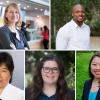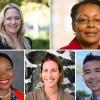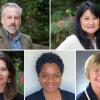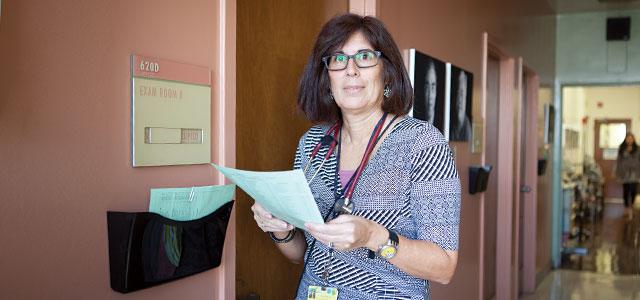
Clarissa Ospina Norvell at San Francisco General Hospital (photos by Elisabeth Fall)
What Volunteer Clinical Faculty Do: Clarissa Ospina Norvell and the Positive Health Program
Volunteer clinical faculty and preceptors offer students individual perspectives and hands-on experience in a variety of health care settings and specialties. The cumulative effect of what these volunteers impart plays a significant role in the care any health system delivers. This series aims to shed light on the unique roles these valuable mentors play.
This month, we hear from Clarissa Ospina Norvell, associate clinical instructor in the Department of Community Health Systems and a nurse practitioner in San Francisco General Hospital’s Positive Health Program, which provides care to patients with HIV/AIDS.
Despite an early interest in science, I never expected to become a nurse. I was born and raised in San Francisco, although I didn’t speak English until I went to school, as my mother is Mexican and my father is South American. I went to UC Santa Barbara, planning to become a veterinarian, but as a surfer, I became interested in aquatic biology and got a BS in that. After graduation, I took a job as a phlebotomist at a large medical center in Santa Barbara and found that I enjoyed the interactions with patients and liked being around medicine.
When I moved back to San Francisco, I got a job as a research associate at UC San Francisco, first recruiting and screening patients and helping to run several bioavailability and pharmacokinetic studies for premarket and postmarket drugs, then assisting internist and clinical pharmacologist Neal Benowitz on his nicotine studies. Working with the nurses at San Francisco General Hospital’s General Clinical Research Center made me think that was something I’d like to do, so I went back to school and got a master’s in case management nursing from San Francisco State University.
I worked with people with HIV/AIDS during my first nursing job on the surgical floor at the San Francisco Veterans Affairs (VA) Medical Center. This was in the late 1980s, and I found that there wasn’t much understanding of how to care for these patients; there was a great deal of fear and stigmatization. I was drawn to it because these people really needed both emotional and physical care. One of my last rotations during nursing school had been doing home hospice work for Kaiser, and I took a job there.
I took care of many people with HIV/AIDS, going to their homes to work with them and their families. It was fulfilling and tiring at the same time because back then, everybody died. I went to more memorials and funerals than I had ever been to in my life. After 15 or 16 years, I needed a break and got a job very removed from hands-on patient care, working at a Kaiser outpatient IV pharmacy with discharge planners and home health nurses to plan for out-of-hospital infusions. I loved working with the pharmacists and learned a lot, but I started to miss the patient contact.
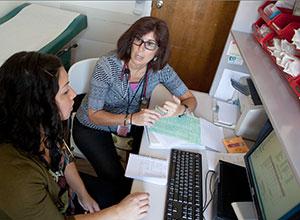 A number of things steered me toward being a nurse practitioner (NP) and eventually continuing my work with HIV/AIDS patients. I had NP friends who encouraged me, and during school, I had also taken care of a very good friend who died of AIDS. I did a post-master’s program at the UC San Francisco School of Nursing with a primary care focus, and an NP friend who works with HIV/AIDS patients said, “It sounds like this is what you want to do.” So in 2001, I applied for a job in the Positive Health Program at San Francisco General Hospital (SFGH).
A number of things steered me toward being a nurse practitioner (NP) and eventually continuing my work with HIV/AIDS patients. I had NP friends who encouraged me, and during school, I had also taken care of a very good friend who died of AIDS. I did a post-master’s program at the UC San Francisco School of Nursing with a primary care focus, and an NP friend who works with HIV/AIDS patients said, “It sounds like this is what you want to do.” So in 2001, I applied for a job in the Positive Health Program at San Francisco General Hospital (SFGH).
I’m stimulated by the science, but I also like the patient contact, and I’m fortunate to have a role that encompasses many different things. In our clinic, I do primary care of patients with HIV/AIDS. Our patients tend to have multiple issues, such as substance abuse, mental health issues or homelessness, that make it challenging for them to prioritize their health, and I enjoy the psychosocial aspects of working with them – and the educational component, teaching people about HIV. I also work in the urgent care drop-in clinic and in the Positive Health Access to Services and Treatment (PHAST) program. It’s an interdisciplinary group of nurses and social work staff who are the first responders for people who come into SFGH and have recently tested positive for HIV. We also care for people who have been positive for many years and have never gotten care for their HIV but present in the emergency department or urgent care, often very ill with opportunistic infections or other life-threatening diseases. Our goal is to link them into care – if not here, then in the community.
I’ve worked with colleagues to form a program for HIV-positive youth, who sometimes have different needs from those of adults. In addition to mental health or substance abuse and homelessness, they’re often estranged from their families and are missing a lot of role modeling and life experience, so an HIV diagnosis is very confusing and overwhelming for them. I also work with an interdisciplinary team to provide care to monolingual Spanish speakers with HIV/AIDS to try to make the experience in our clinic more accessible for them. Many begin HIV care unintentionally; they go to the emergency department for one thing and end up being diagnosed with HIV or AIDS. It’s a community that is very silent about HIV, and there’s still a great deal of stigma. The trauma in the immigrant population is astounding; they’re often undocumented and very vulnerable, so caring for them presents some unique challenges.
I’m also involved with the OPTIONS Project, a multistudy research program that looks at patients newly infected with HIV to understand the early course of the disease. There are numerous ongoing studies into things like whether early intervention with medication is helpful, and what happens when you treat for a while and then stop.
One of the highlights of my career was the opportunity to work with PEPFAR, the federal government’s program to combat AIDS around the world, on one of its projects in Zambia. I spent eight months between 2004 and 2005 in various locations throughout that country, educating physicians, nurses and volunteers about HIV treatment, medications and side effects. I went there thinking that, with all my hospice experience, I would somehow be prepared to deal with death, but the magnitude of what I witnessed was overwhelming. There were entire families coming in infected, and grandparents raising small children because both parents were dead. I’ve gone back several times, and it’s been great to see the program grow and to see people actually get better.
Suzan Stringari-Murray (health sciences clinical professor at the UC San Francisco School of Nursing) was the one who mobilized NPs at the Positive Health Program to get involved with teaching, but she didn’t have to do too much prodding. I started doing lectures in the School’s HIV/AIDS minor, then started taking first-year NP students, teaching them how to take a medical history and do a physical exam. I’ve recently started working with a second-year student as well. One very important piece in my teaching is modeling communications, as we have a complicated group of patients and it can be challenging to meet them halfway. It takes a lot of patience and understanding, and it’s not something you can learn in a book or a classroom. I work with the students in the OPTIONS research clinic because there’s more time there, but I also offer them the option to come to the clinic to see what it’s like.
Students can come in feeling overwhelmed and insecure. I enjoy being able to mentor them, and I try to allow them to come into their own way of practicing over the time we have together. I like to support them through the learning process and to show them how varied the NP role can be.
I came to my work in a funny way – initially wanting to work with animals, fish and algae – and then when I did my rotation in psychiatry, I thought I’d never want to do that as a career. Now not only am I working with humans, but a big part of my practice is dealing with psychological issues, and it’s very fulfilling. It’s been great going from hospice, where I buried most of my patients, to having patients who go on to live their lives, building careers and even having families. But there’s still a lot of stigma and fear around HIV/AIDS, and we have a great deal of work to do. I’m hoping that someday we’ll have a cure.

